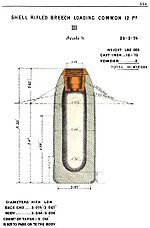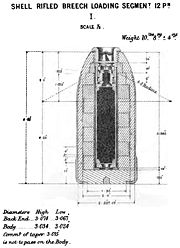
RBL 12 pounder 8 cwt Armstrong gun
Encyclopedia
The Armstrong Breech Loading 12 pounder 8 cwt, later known as RBL 12 pounder 8 cwt, was an early modern 3-inch rifled breech-loading field gun
of 1859.
 The gun incorporated some advanced features for its day. It was one of the first breech-loaders: shell and gunpowder propellant were loaded through the gunner's end of the barrel, rather than through the muzzle as in previous guns, allowing a higher rate of fire. The shells were coated with lead, which engaged spiral grooves cut inside the barrel ("rifling") and caused the shell to spin rapidly in flight and hence imparted far greater accuracy and range than previous guns. The lead coating effectively sealed the gap between shell and barrel and eliminated the wastage of propellant gases, previously known as "windage", and hence only half the amount of gunpowder propellant as previous was required.
The gun incorporated some advanced features for its day. It was one of the first breech-loaders: shell and gunpowder propellant were loaded through the gunner's end of the barrel, rather than through the muzzle as in previous guns, allowing a higher rate of fire. The shells were coated with lead, which engaged spiral grooves cut inside the barrel ("rifling") and caused the shell to spin rapidly in flight and hence imparted far greater accuracy and range than previous guns. The lead coating effectively sealed the gap between shell and barrel and eliminated the wastage of propellant gases, previously known as "windage", and hence only half the amount of gunpowder propellant as previous was required.
The barrel was of wrought iron
, "built up" of a tube with additional layers heated and then shrunk over it as they cooled. The result was a "pre-stressed" barrel: the interior of the barrel was under compression from the layers shrunk over it, so that the heat and pressure of firing did not stretch it. Hence the barrel was smaller and lighter than previous guns.
Unfortunately, the new technology involved required higher standards of gun maintenance and gunner training than the British army was prepared to provide, with the result that in service the gun had a reputation for unreliability. In 1871 Britain reverted to muzzle-loading guns, which were cheaper and fired much cheaper ammunition, with the RML 9 pounder 8 cwt.
, in Australia), sold 6 Armstrong 12-pounders to New Zealand
for use in the Māori wars, for a sum of 3,592 pounds 1s 8d with equipment and ammunition. They travelled from Melbourne
on 7 November 1863 on the troopship Himalaya, and arrived in Auckland
on 11 November 1863.
The Victorian Government purchased 6 more guns in 1864 to equip its horse artillery; one of these is restored and displayed at the Australian War Memorial
in Canberra
.
. Captain Mercer again led this battery in the Second Taranaki War
until he died leading an unsuccessful attack on a Maori redoubt at Rangiriri
in November 1863. In January 1864 "I" battery, equipped with the "New pattern" of 24-calibres, arrived in New Zealand with another 6 guns. The guns from Victoria were employed from January 1864 onwards to reinforce "C" and "I" batteries. At the end of the war these guns apparently remained in New Zealand where they were used to equip the militia.
Field gun
A field gun is an artillery piece. Originally the term referred to smaller guns that could accompany a field army on the march and when in combat could be moved about the battlefield in response to changing circumstances, as to opposed guns installed in a fort, or to siege cannon or mortars which...
of 1859.
Design

The barrel was of wrought iron
Wrought iron
thumb|The [[Eiffel tower]] is constructed from [[puddle iron]], a form of wrought ironWrought iron is an iron alloy with a very low carbon...
, "built up" of a tube with additional layers heated and then shrunk over it as they cooled. The result was a "pre-stressed" barrel: the interior of the barrel was under compression from the layers shrunk over it, so that the heat and pressure of firing did not stretch it. Hence the barrel was smaller and lighter than previous guns.
United Kingdom service
The gun was the British army's first rifled breechloading field gun, superseding the SBML 9 pounder 13 cwt in 1859. The gun as originally adopted had a barrel 84 inches long, with a bore of 73.375 inches. The Royal Navy adopted a version with a 72 inch barrel, with a bore of 61.375 inches, by simply cutting 12 inches off the end, and from 1863 the shorter length was incorporated into a common version for both land and sea use.Unfortunately, the new technology involved required higher standards of gun maintenance and gunner training than the British army was prepared to provide, with the result that in service the gun had a reputation for unreliability. In 1871 Britain reverted to muzzle-loading guns, which were cheaper and fired much cheaper ammunition, with the RML 9 pounder 8 cwt.
Colony of Victoria service
The Colony of Victoria (today the State of VictoriaVictoria (Australia)
Victoria is the second most populous state in Australia. Geographically the smallest mainland state, Victoria is bordered by New South Wales, South Australia, and Tasmania on Boundary Islet to the north, west and south respectively....
, in Australia), sold 6 Armstrong 12-pounders to New Zealand
New Zealand
New Zealand is an island country in the south-western Pacific Ocean comprising two main landmasses and numerous smaller islands. The country is situated some east of Australia across the Tasman Sea, and roughly south of the Pacific island nations of New Caledonia, Fiji, and Tonga...
for use in the Māori wars, for a sum of 3,592 pounds 1s 8d with equipment and ammunition. They travelled from Melbourne
Melbourne
Melbourne is the capital and most populous city in the state of Victoria, and the second most populous city in Australia. The Melbourne City Centre is the hub of the greater metropolitan area and the Census statistical division—of which "Melbourne" is the common name. As of June 2009, the greater...
on 7 November 1863 on the troopship Himalaya, and arrived in Auckland
Auckland
The Auckland metropolitan area , in the North Island of New Zealand, is the largest and most populous urban area in the country with residents, percent of the country's population. Auckland also has the largest Polynesian population of any city in the world...
on 11 November 1863.
The Victorian Government purchased 6 more guns in 1864 to equip its horse artillery; one of these is restored and displayed at the Australian War Memorial
Australian War Memorial
The Australian War Memorial is Australia's national memorial to the members of all its armed forces and supporting organisations who have died or participated in the wars of the Commonwealth of Australia...
in Canberra
Canberra
Canberra is the capital city of Australia. With a population of over 345,000, it is Australia's largest inland city and the eighth-largest city overall. The city is located at the northern end of the Australian Capital Territory , south-west of Sydney, and north-east of Melbourne...
.
New Zealand Land Wars
"C" Battery, 4th Brigade Royal Artillery, with 6 guns, served in New Zealand under Captain Mercer, in March 1861 in the final stages of the First Taranaki WarFirst Taranaki War
The First Taranaki War was an armed conflict over land ownership and sovereignty that took place between Māori and the New Zealand Government in the Taranaki district of New Zealand's North Island from March 1860 to March 1861....
. Captain Mercer again led this battery in the Second Taranaki War
Second Taranaki War
-Background and causes of the war:The conflict in Taranaki had its roots in the First Taranaki War, which had ended in March 1861 with an uneasy truce. Neither side fulfilled the terms of the truce, leaving many of the issues unresolved...
until he died leading an unsuccessful attack on a Maori redoubt at Rangiriri
Rangiriri
Rangiriri was a rural New Zealand parliamentary electorate in the Auckland Region from 1978 to 1984.-History:The electorate existed only from 1978 to 1984: it replaced the Franklin electorate in 1978, but the name was changed back to Franklin in 1984....
in November 1863. In January 1864 "I" battery, equipped with the "New pattern" of 24-calibres, arrived in New Zealand with another 6 guns. The guns from Victoria were employed from January 1864 onwards to reinforce "C" and "I" batteries. At the end of the war these guns apparently remained in New Zealand where they were used to equip the militia.
Ammunition
 |
 |
|
Surviving examples
- Australian War Memorial, Canberra
- Municipal Museum, Te AwamutuTe AwamutuTe Awamutu is a town in the Waikato in the North Island of New Zealand. It is the council seat of the Waipa District and serves as a service town for the farming communities which surround it...
, New Zealand - Royal Artillery MuseumFirepower - The Royal Artillery MuseumFirepower: The Royal Artillery Museum is a military museum in Woolwich in south-east London, England, which tells the story of the Royal Regiment of Artillery and of the Royal Arsenal.-History:...
, WoolwichWoolwichWoolwich is a district in south London, England, located in the London Borough of Greenwich. The area is identified in the London Plan as one of 35 major centres in Greater London.Woolwich formed part of Kent until 1889 when the County of London was created...
, LondonLondonLondon is the capital city of :England and the :United Kingdom, the largest metropolitan area in the United Kingdom, and the largest urban zone in the European Union by most measures. Located on the River Thames, London has been a major settlement for two millennia, its history going back to its...

